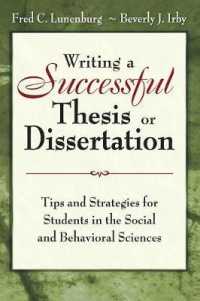- ホーム
- > 洋書
- > 英文書
- > History / World
基本説明
The author uses a rich array of illustrative material to demonstrate that Mary did not disappear from Protestant devotional life, and that in Catholic areas devotion to the Virgin did not always displace more traditional forms of Marian piety.
Full Description
What happened to the fervent Marian piety of the late Middle Ages during Germany's Reformation and Counter-Reformation? It has been widely assumed that Mary disappeared from Protestant devotional life and subsequently became a figurehead for the Catholic Church's campaign of religious reconquest. This book presents a more finely nuanced account of the Virgin's significance. In many Lutheran territories Marian liturgy and images - from magnificent altarpieces to simple paintings and prints - survived, though their meaning was transformed. In Catholic areas baroque art and piety flourished, but the militant Virgin associated with the Counter-Reformation did not always dominate religious devotion. Traditional manifestations of Marian veneration persisted, despite the post-Tridentine Church's attempts to dictate a uniform style of religious life. This book demonstrates that local context played a key role in shaping Marian piety, and explores the significance of this diversity of Marian practice for women's and men's experiences of religious change.
Contents
Introduction; 1. Transformations in Marian teaching; 2. Marian piety in Lutheran Germany; 3. Confessional frictions and the status of the Virgin; 4. The Counter-Reformation cult; 5. Catholic pluralism and Cologne; 6. Marian devotion and gender; Conclusion; Bibliography; Index.







